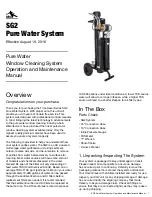
5
3. Installation
3.1. Preparations For Installation
Do not carry out any unauthorised conversions
or alterations to the turbopump.
– The option to connect two of accessory components is
provided on the Connection Box TCS 010 (please see
"Accessories") which is secured into the Electronic Drive
Unit TC 100.
– With Pumping Station Control Unit TCS 010 it is possible to
connect accessory units (please see "Accessories").
– The maximum permissible rotor temperature of the pump is
90 °C. If the vacuum chamber or parts in the vacuum
chamber are heated must be fitted if necessary, suitable
shielding in the vacuum chamber before the turbopump
(constructional suggestions available on request).
– Only remove the blank flange from the high and fore-vacu-
um side immediately before connection.
– On Turbopumps TMH 262/TMU 262 the lubricant reservoir
is already fitted and filled.
– Where magnetic fields of > 5.5 mT are involved suitable
shielding must be provided (available on request).
– If the pump is baked out, the heating sleeve and the body
of the pump must be insulated to prevent burns from
accidental contact.
– In the event of a sudden standstill of the rotor, torques of
up to 750 Nm can arise and these must be taken up by the
turbopump and frame. Pumps must be anchored as
follows:
– ISO flange with 4 bracket screws, or
– CF flange with the complete set of M8 screws, or
– Underside of the pump with 4 screws M8,
screws quality 8.8.
– For operating the pump air or water cooling is necessary.
3.2. Installing The Pump,
Connecting The High Vacuum Side
The utmost cleanliness must be observed when
fitting all high vacuum parts. Unclean
components prolong the pumping time.
Using the splinter shield
The use of a splinter shield in the high vacuum flange
protects the turbopump against foreign bodies coming from
the vacuum chamber but does reduce the volume flow rate of
the pump by approximately 15%.
For fitting splinter shields please refer to “Fitting the splinter
shield”
The high vacuum side can be flanged directly to the vacuum
chamber or via a bellows or a vibration compensator from
Pfeiffer (please see ”Accessories”).
Connecting via a bellows
If the high vacuum side is to be flanged via a bellows, the tur-
bopump must be secured for example via the holes on the
underside of the turbopump must be secured for example via
the holes on the underside of the pump. The fastening must
be able to withstand the torque referred to in Section 3.1.
Connecting via a Pfeiffer vibration compensator (Accessory)
The maximum permissible temperature at the
vibration compensator is 100 °C.
Where a Pfeiffer vibration compensator from Pfeiffer is in
use, a freely suspended turbopump can be flanged onto the
vacuum chamber. Additional fastening is unnecessary.
☞
PLEASE NOTE






































